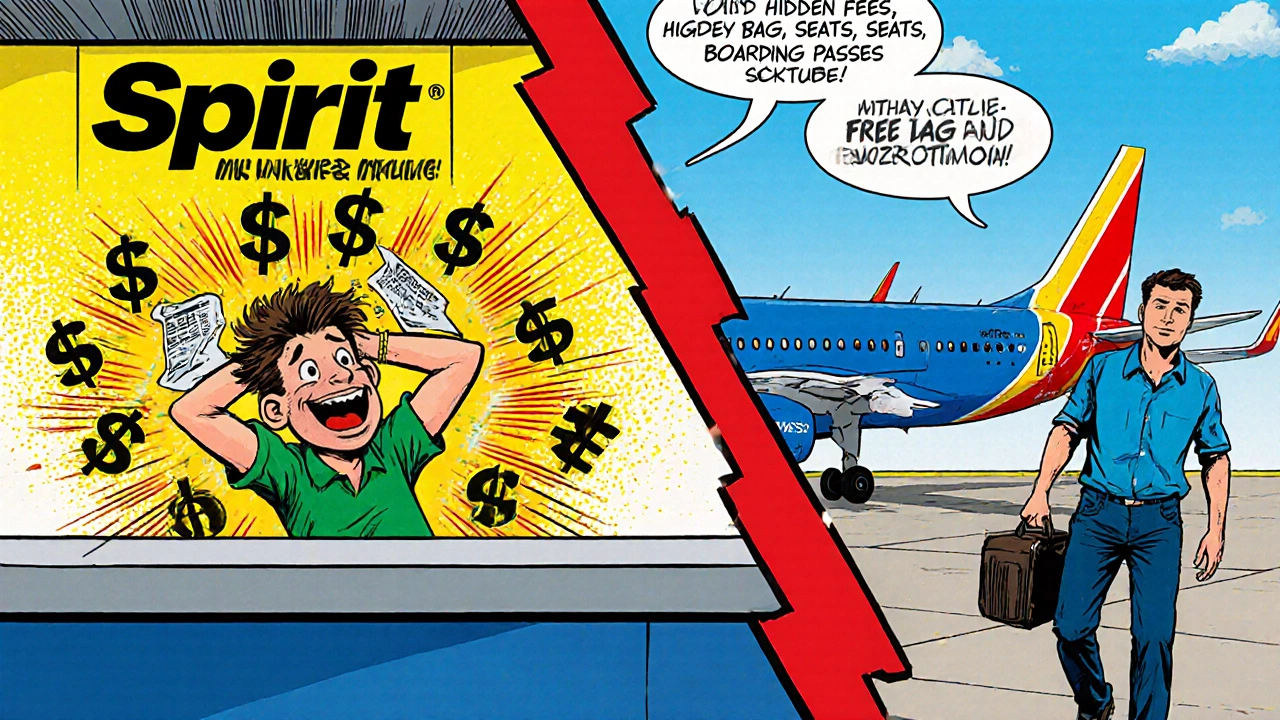Budget Flight Cost Calculator
Find Your Cheapest Option
Total Cost Breakdown
Total Cost
$0
Recommended Airlines
If you're looking to save money on your next trip, the cheapest airline isn't a single name you can pin to a map. It changes depending on where you're flying from, where you're going, when you're traveling, and even what time of day you book. There’s no universal winner like ‘Airline X always costs less.’ But there are patterns, strategies, and real airlines that consistently deliver the lowest fares - if you know how to find them.
Low-Cost Carriers Dominate Budget Routes
When people ask for the cheapest airline, they usually mean a low-cost carrier (LCC). These airlines cut costs by removing extras like free checked bags, assigned seating, and meals. In return, they offer base fares that can be 50-70% lower than traditional airlines. In 2025, the top budget airlines globally include Ryanair, EasyJet, Wizz Air, Spirit Airlines, Frontier Airlines, and AirAsia.
For example, a one-way flight from London to Warsaw on Wizz Air can start at $18 if booked months ahead. The same route on British Airways might cost $120 or more. That’s not a fluke - it’s the model. These airlines make money not from ticket prices, but from add-ons: baggage fees, seat selection, priority boarding, and even selling water on board.
Where You Fly From Matters More Than the Airline
Don’t just look at the airline - look at the airport. Flying out of a secondary airport can slash your fare by hundreds of dollars. In Europe, flying from Milan Bergamo instead of Milan Malpensa, or from Paris Beauvais instead of Charles de Gaulle, often means choosing a budget airline with rock-bottom prices.
In the U.S., flying from Oakland instead of San Francisco, or from Long Beach instead of LAX, can save you 30-50% on the same destination. Southwest Airlines, for instance, doesn’t charge change fees or baggage fees, but it doesn’t fly into every major airport. If you’re flexible, you’ll find cheaper options.
Use flight search tools like Google Flights or Skyscanner and toggle the ‘nearby airports’ option. You’ll be surprised how often the cheapest flight leaves from a place you never considered.
Timing Is Everything - Even More Than the Airline
Booking at the right time beats picking the ‘cheapest’ airline every time. Data from 2025 shows that the sweet spot for domestic U.S. flights is 54 days before departure. For international trips, aim for 120-150 days out. Prices spike dramatically in the final 30 days, especially for weekend travel.
Also, avoid flying on Fridays and Sundays. Those are the most expensive days. Tuesdays and Wednesdays are consistently the cheapest. A flight from New York to Miami on a Tuesday in January might cost $89. On Sunday? $210. That’s not the airline’s fault - it’s demand.
Set price alerts on Google Flights or Hopper. These tools track fare trends and notify you when prices drop. I’ve seen people save $300+ just by waiting a week after setting an alert.

Regional Winners: Where the Cheapest Airline Changes
The cheapest airline isn’t the same everywhere. Here’s what’s working in 2025:
- Europe: Wizz Air and Ryanair dominate Eastern and Central Europe. For routes between Western European cities, EasyJet often beats them on comfort and reliability - even if the price is slightly higher.
- North America: Spirit and Frontier are the undisputed budget kings. But they fly to fewer destinations. If you need to get to a smaller city, check Allegiant Air - they specialize in underserved routes with fares under $50 one-way.
- Asia: AirAsia and Scoot offer the lowest fares across Southeast Asia. A flight from Bangkok to Ho Chi Minh City can cost as little as $25 if booked early.
- Australia/New Zealand: Jetstar and Scoot are the go-to for budget flights between major cities. Virgin Australia’s budget arm, Virgin Australia Regional, sometimes undercuts them on regional routes.
- Latin America: Volaris in Mexico and Flybondi in Argentina consistently offer the lowest fares. In Brazil, Azul has aggressive pricing on domestic routes.
Hidden Costs That Make ‘Cheap’ Flights Expensive
Here’s the catch: the lowest fare you see is rarely the final price. Budget airlines charge for almost everything beyond the seat. A $49 ticket can turn into a $150 trip after adding:
- Checked bag ($30-$60)
- Carry-on bag (if it’s too big - Spirit charges $45 for a carry-on that doesn’t fit under the seat)
- Seat selection ($5-$25)
- Boarding priority ($10-$20)
- Printed boarding pass ($10 at the airport)
That’s why comparing total price matters. Use Hopper or Kiwi.com to see the full cost - including all mandatory fees - before you book. Don’t fall for the bait-and-switch. Some airlines hide fees until the last step of checkout. Always check the final total before clicking ‘buy’.
When It’s Worth Paying More
Not every trip needs to be the cheapest. Sometimes, paying a little more saves you time, stress, and money in the long run.
If you’re traveling with kids, a family of four might spend $200 extra on baggage and seat selection with Spirit - and still end up crammed in the back row with no legroom. A $200 flight on Southwest might include two free checked bags, no change fees, and more space. You’re not paying more - you’re paying less for the hassle.
Same goes for long-haul flights. A $120 flight from New York to Chicago on a budget carrier might take 5 hours with two layovers. A $250 direct flight on Delta or American might get you there in 3 hours. Time is money, especially if you’re on a tight schedule.
Pro Tips to Always Get the Lowest Fare
Here’s what works right now in 2025:
- Book directly on the airline’s website - third-party sites sometimes add hidden fees or make refunds harder.
- Clear your browser cookies or use incognito mode. Some sites track your searches and raise prices.
- Use incognito mode for price checks - some sites track your searches and raise prices.
- Pay in the airline’s local currency if you’re booking internationally. Sometimes, paying in euros or pesos instead of dollars saves 5-10%.
- Join airline loyalty programs - even budget ones. You can earn points on extras like baggage and get discounts on future flights.
- Travel mid-week and avoid holidays. Christmas, New Year’s, and summer break are the most expensive times.
Final Answer: There’s No Single Cheapest Airline
The cheapest airline is the one that matches your route, timing, and willingness to pay for extras. For short European hops, Wizz Air wins. For budget flights across the U.S., Spirit and Frontier are unbeatable - if you pack light. For Asia, AirAsia is the go-to. But none of them are cheap if you need to check a bag, pick a seat, or board early.
Your best move? Use Google Flights to compare total prices across airlines. Filter by ‘lowest total price’ - not just the base fare. Then book directly. That’s how you find the real cheapest option - not by guessing which airline is ‘the cheapest,’ but by knowing exactly what you need and paying only for it.
Is there one airline that’s always the cheapest?
No. The cheapest airline depends on your route, departure city, travel dates, and how much you’re willing to pay for extras. Budget airlines like Ryanair, Spirit, and Wizz Air often have the lowest base fares, but their total cost can rise quickly with baggage and seat fees.
How do I avoid hidden fees on budget airlines?
Always check the final price before booking - including all add-ons. Use tools like Hopper or Kiwi.com that show the total cost upfront. Pack only a personal item that fits under the seat, skip seat selection unless necessary, and avoid printing your boarding pass at the airport.
Are budget airlines safe?
Yes. Airlines like Ryanair, Wizz Air, and Spirit are regulated by aviation authorities in their home countries and meet international safety standards. Safety ratings from organizations like AirlineRatings.com show most low-cost carriers have strong safety records. The trade-off is comfort and service, not safety.
Should I book directly with the airline or use a third-party site?
Book directly with the airline. Third-party sites like Expedia or Kayak sometimes show lower prices, but they can make refunds, changes, or customer service much harder. If your flight is canceled or delayed, the airline handles it directly - not a middleman.
What’s the best time to book a cheap flight?
For domestic flights, book 54 days in advance. For international trips, aim for 120-150 days. Avoid booking during holidays or on weekends. Tuesdays and Wednesdays are the cheapest days to fly. Set price alerts to catch drops.





